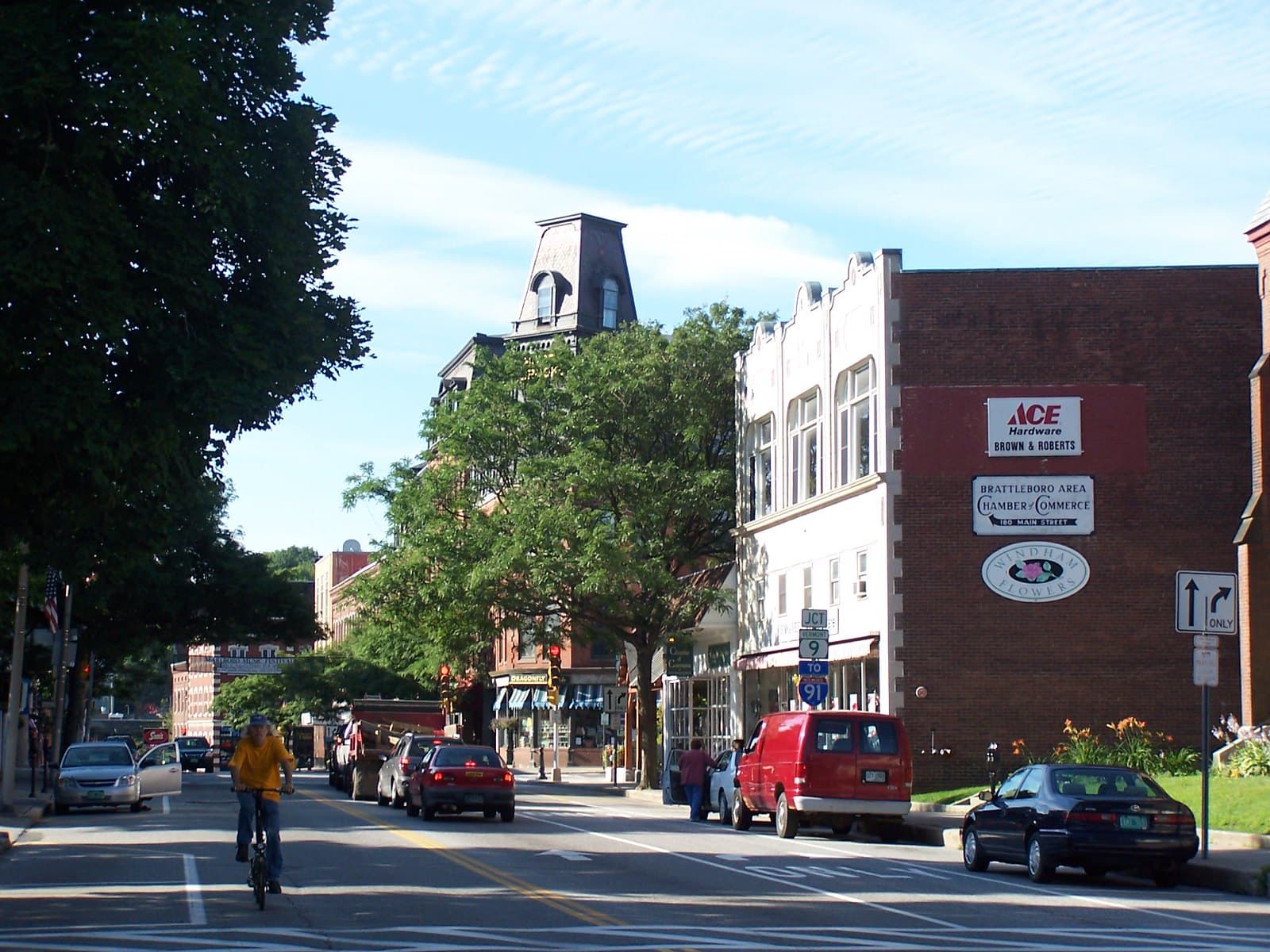
News
By Dustin Robertson, August 6, 2024
One major misconception we encounter in our work is that smart growth principles like Complete Streets, public transit, and mixed-use development are just for big cities and don’t apply to small towns. But over the years, we’ve seen countless examples of rural places that used these strategies to great benefit. I recently traveled to such a place–Brattleboro, Vermont.

Brattleboro is a town of around 12,000 people in southern Vermont, near the borders of Connecticut and New Hampshire. Although the town is small in terms of geography and population, during my short visit, I saw many smart growth strategies that other towns and rural areas could try. The result of these policies and features make Brattleboro a great place for residents and visitors alike. In fact, our friends at Strong Towns named Brattleboro the ‘Strongest Town’ of the year in 2023.
Often, we come across a misconception that smart growth is for urban places, not rural ones. But Brattleboro's success shows that this is just one of many myths about small towns in America that need to be laid to rest. Here are a few other small town myths that Brattleboro defies.
Myth: Is everyone always driving in rural America?
Because of high car dependence in rural areas, there’s an assumption that cars should be prioritized and towns shouldn’t worry about pedestrians. However, Brattleboro’s Main Street and other principal streets have multiple features that make them safe and pedestrian-friendly, resulting in the town avoiding any pedestrian fatalities for over a decade.
The speed limit of 25 miles per hour on streets and relatively narrow road designs mean that cars are not zooming through at high speeds. Numerous shops, cafes, restaurants, parks, and seating areas built in close proximity to one another encourage people to stroll, window-shop, and run errands without using a car. On an average day, one sees a mix of people out walking and moving about Brattleboro in a safe and comfortable way.

Other pedestrian-friendly features include signalized pedestrian scramble intersections. This means that pedestrians can cross in any direction they choose at an intersection (straight, left, right, diagonal, zig-zag). When the pedestrian sign comes on, an audible message announces “Walk sign is on for all crossings.” Cars are stopped in all directions and cannot turn right on red. Rather than having to watch for cars coming from different directions, pedestrians can cross in peace.
Myth: Can passenger rail and train stations support small towns?

One of the main reasons my partner and I chose to travel to Brattleboro in the first place was that we could get there by train. From Washington D.C., we rode the Vermonter which also serves many towns and cities along the way, including Baltimore, Philadelphia, and New York. What’s more, the Brattleboro train station is right in the center of town, just 300 feet from Main Street with the town’s food co-op, numerous restaurants, and stores within a few minutes walk.
But trains aren’t just a nice way for tourists to get around, they also connect people to jobs, family, and other important destinations. For towns, they can attract visitors, customers, and future residents seeking to reduce their car dependance.
Train travel in Brattleboro will soon get even better. Thanks to funding from the 2021 infrastructure law (the Infrastructure Investment and Jobs Act, or IIJA), the town recently began construction of a new station with an ADA accessible high-level platform, waiting area, bike shelter, electric vehicle chargers, and restrooms.
Myth: Is transit feasible in rural places?

Brattleboro has a public transit system called the MOOver which offers both fixed-route service and door-to-door transportation for riders over sixty and people with disabilities. And yes, of course the buses are painted black or red and white in Holstein cow patterns. And that’s not the only cool thing about the MOOver. Through a combination of federal, state, and local funding, the MOOver is also completely free to ride!
Myth: Is it possible to manage parking in small towns?
Brattleboro requires payment for all on-street parking (2 hour limit) and the handful of lots around the town. These policies mean that Brattleboro is making efficient use of its space, generating funds for other uses, and not giving away valuable (and limited) downtown real estate for empty parking spaces. Recently, Brattleboro doubled down on their parking management, with the town’s selectboard voting to raise rates for parking and to charge for parking on Sunday (which was previously free).
Myth: Can small towns help combat the housing crisis?
Though this is a smart growth area I didn’t experience firsthand, Vermont currently has a crisis of housing access and affordability. Vermont home prices spiked more than any other state in 2023, and the number of houses sold in the state declined to the lowest level since 2012. This means that houses are both hard to find and increasingly expensive in Vermont.
However, Brattleboro is one place that is working to reduce housing barriers and create more options for affordable housing. This includes numerous smart growth principles like increasing density creating a "missing middle housing" district. These strategies, which build on a supportive policy context that Smart Growth America helped promote including recent bills S100 and S687, can help Brattleboro and other small towns meet housing needs of the current population and attract new residents who want to relocate there.
What does it all mean?
Misconceptions about small towns hide what's possible and do a disservice to all the innovative rural communities that are finding new ways to improve the quality of life for their residents. Brattleboro is a great illustration of how smart growth principles can and should be applied to towns and rural areas across the country. You can find even more examples of how smart growth helps advance rural development in our past report, An Active Roadmap: Best Practices for Rural Mobility.
Related News

© 2026 Smart Growth America. All rights reserved
Site By3Lane Marketing









